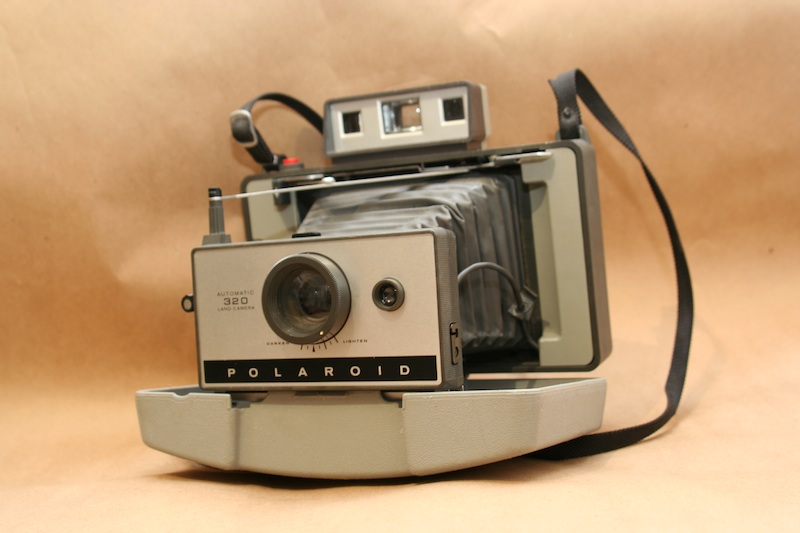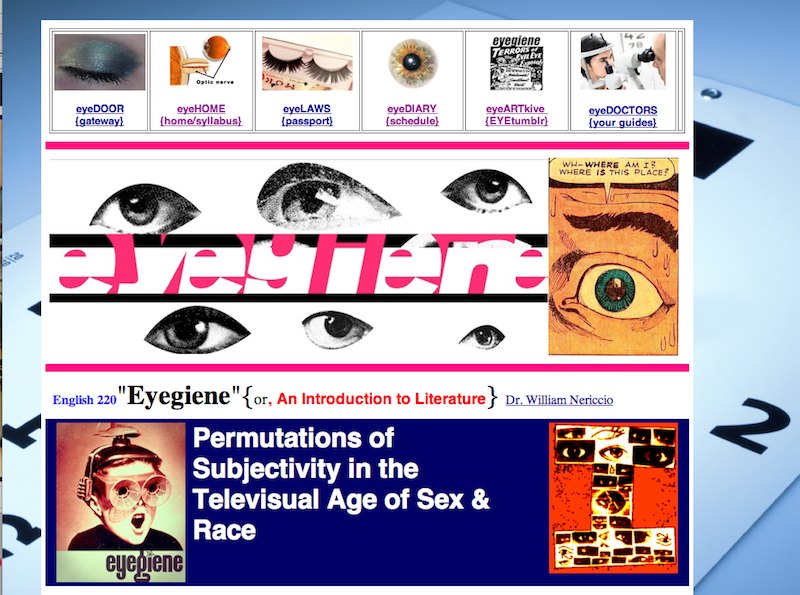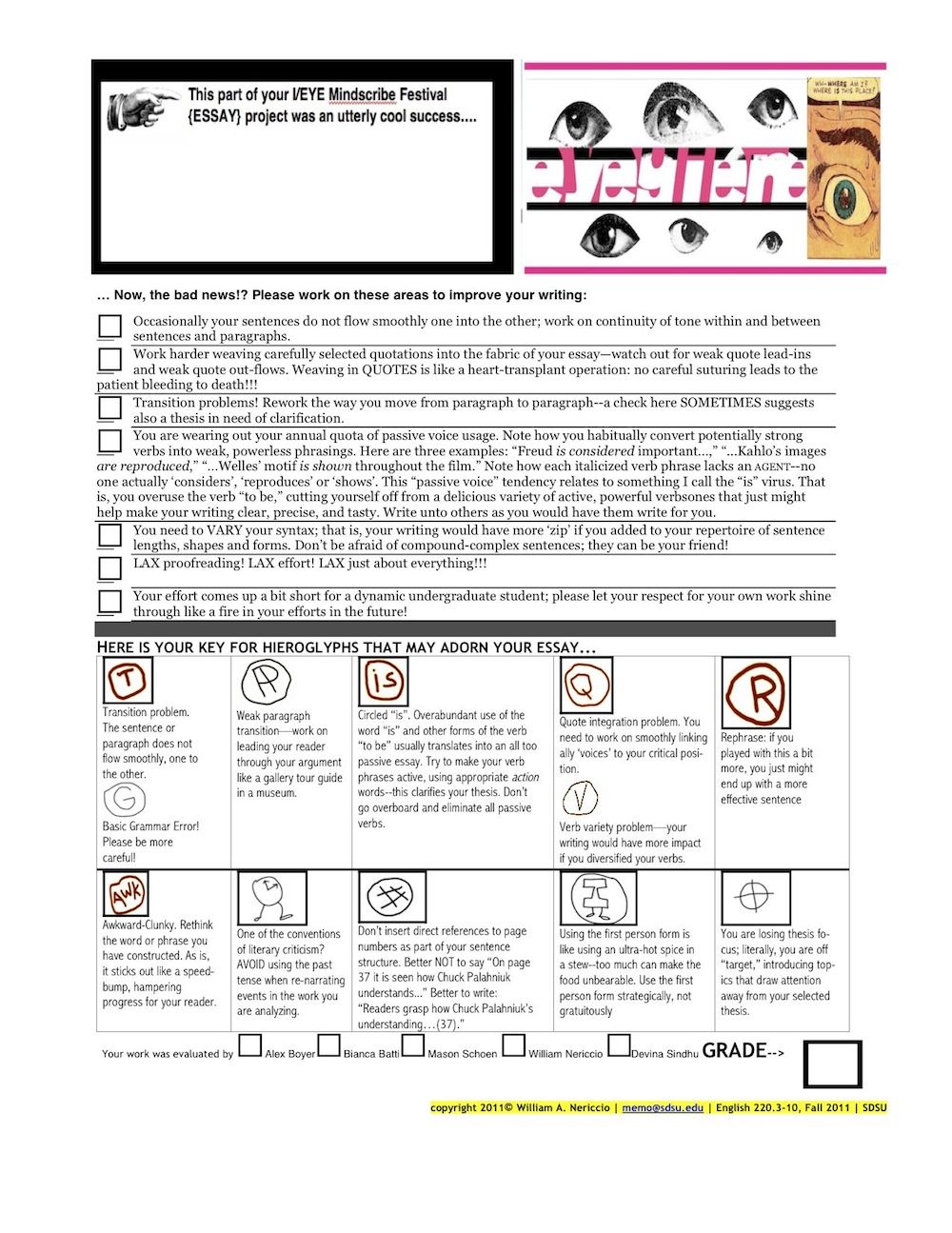 |
| Engl 220.3-220.10 | Fall 2011 |
| I/EYE Mindscribe Festival Challenge Numero Uno®
urgent issues? email: memo@sdsu.edu | phone: 619.594.1524
Some of you will not be comfortable with this. So if you want to write and turn in an ESSAY, then remember what an "essay" can be. Elegant, eclectic, and clever (not to mention an American original when it comes to writing), Gore Vidal reminds young writers that a peek into the fabulous history of the word essay, an etymological poke into the labyrinth of essay's past, reveals other words you might not have expected to run across: "trying," "testing," and "rehears[ing]." You see most people think of an essay as a finished product--a dull, lifeless, inert textual body with a static introduction, an "ABCD" body, and a clear lets-tie-up-all-the-pieces conclusion. You will not write this kind of essay, opting instead to produce something that is less product and more process, less finished, museum-bound artifact, and more beautiful symphony. Allow the OED, the Oxford English Dictionary to show you the "guts," the DNA of the term "essay," with its Jeckyll/Hyde twin, "assay": [a. OF. essai, essay: see ASSAY n. For several of the senses see also SAY.
In 18th c. the accent. was sometimes on the 2nd syll.] I. The action or process of trying or testing. 1. A trial, testing, proof; experiment; = ASSAY n. 1, 3. Obs. c1600 SHAKES. Sonn. cx, Worse essays proved thee my best of love. 1605 BACON Adv. Learn. II. vii. §7 Democritus..attributed the form thereof [of the ‘frame of things’] able to maintain itself to infinite essaies or proofs of nature. 1631 HEYLIN St. George 247, I will make bold to venture on it, by way of tryall and essay. 1648 Eikon Bas. 26 It was the first overt Essay to be made, how patiently I could bear the loss of my kingdoms. 1660 SHARROCK Vegetables Ep. Ded., You were pleased to judge me able, and..to propose..that I should make an essay of that ability. 1704 ADDISON Italy (1733) 195 After having made Essays into it, as they do for Coal in England. 1745 De Foe's Eng. Tradesman I. xii. 98 He has made an essay by which he knows what he can, and cannot do. 1812 J. HENRY Camp. agst. Quebec 28 From the essays made, it seemed to me that, etc. b. spec. The trial of metals; = ASSAY 6. Obs. So, for the purposes of this writing/research challenge, I am asking for you to return to the origins of the essay. Your mandated task is to make a sincere attempt (a trying, a testing, a rehearsing) to produce a set of ordered reflections, a group of carefully arranged tasty words that respond in some way to the novels, films, art, cultural criticism, and lectures you have worked through and will continue to work through in the coming weeks. Are you writing for your professor and your talented quartet of GTAs? In a way, of course
you are. But
in order to do well on this assignment, you must forget about your peculiar guide--the
only people who count are the readers you write for: the audience for your
paper.
Who are they? Well, they are a lot like you. They are impatient and easily bored. They like specific details; they love direct, succinct quotes woven carefully into the fabric of an essay. If you are going to write about an image, they want to see a xeroxed reproduction of that image properly captioned and carefully catalogued in your list of works cited. They hate misspellings and passive verbs. They like tangy language which is fresh and not filled with predictable clichés. Specifications, you ask? Here they are: Your
essays will run anywhere from 3 to 5 pages
(tops). At the top of the first page, above your title, you will write out the prompt to which you are responding. Your essay will be cleverly titled, double-spaced, have 1-inch margins
top and sides and be carefully
proofread; additionally, it will be chock-full of active verbs and, in
general, have syntactic variety so as to avoid the dangers of the IS
VIRUS; use MLA or University of Chicago-style works cited pages. Your works of genius are
due Wednesday, October 19, 2011 in class--you will walk into class on
time and drop your paper into the decorated receptacle that corresponds
to your specific section (there will be one other bag with my name on
it as well if you want me to grade your hard work). All A-level critical speculations will integrate carefully selected direct quotations from the primary texts and will avoid ALL of the quicksand-like bad habits noted here on the gradesheet to your right--click it to make it readable. gradesheet. One last bit of advice, do NOT plagiarize ANY material from the internet; unCITED material = PLAGIARISM (if your essay cuts and pastes any material from wikipedia, you might as well go back to 7nth grade; also, if you are going to "quote" a passage from an illustrated text, go to the bother of xeroxing the image and incorporating it INTO your essay. Last hint? Have a blast with this paper! Try things you have NEVER tried before! Test the limits of your imagination! Especially for graduating seniors: put everything you know on and between the lines of your big scary imagination blow-out! Good luck: with your talents, you may not need it! Choose ONE of the following prompts... Freud, Freud, Freud Department 1. In Zarate and Appignanesi’s Freud for Beginners, we are presented with Sigmund Freud’s theory of psychoanalysis. In his various ideas, Freud argues that our sexual identity is formulated and constructed during our formative years of psychosexual development. Write an essay in which you make an argument that shows how Freud’s theories are influential to or could be helpful in the understanding of the relationship dynamics of the subjects/characters in a two particular works we have studied in class. NOTE: "Works" include any major text, film, writer, artist, director covered in our seminar) Inventing the Self Department 2. In her
book, Frida Kahlo, Andrea Kettenman writes, “Frida Kahlo’s
self-portraits helped her shape an idea of her own person; by creating
herself anew in art as in life, she could find her way to an
identity” (20). Make an argument that shows how an
author/character/subject in a work we have studied in class constructs,
shapes, fabricates, invents an “idea of [his/her] own
person” through the work or art, film, or literature. How does
the author/subject/character “find [a] way to an identity”
and how do they portray it? Women's Studies Department, Frida Kahlo Edition 3. Diego Rivera describes how Frida Kahlo is “the first woman in the history of art to treat, with absolute and uncompromising honesty, one might even say with impassive cruelty, those general and specific themes which exclusively affect woman” (Kettenmann 51). Write an essay that analyzes how various aspects of Kahlo’s art illuminate her particular experiences and subjectivity as a woman; contrast Frida with at least one other major female character/author we have encountered this term. Fractured Self Department 4. During
class several weeks ago, we began exploring the concept of “the
fractured self,” and last week we also considered the theme of
“the tattooed psyche.” Both of these concepts reveal an
understanding of the fact that our identities—our perceptions of
self—are formed, complicated, problematized, reshaped by trauma
or conflict. Keeping these ideas in mind, how do you see this idea of
the fractured self manifested in both The Lady from Shanghai and Palahniuk’s Fight Club?
Consider characters from each text that are fractured and why this may
be significant in how we think about the idea of the formation of
one’s subjectivity. A-level Eye/I Mindscribe Festival projects
will incorporate direct quotes woven in carefully from the novel (and,
extra-bonus, the film). Probing the Labyrinths of the Unconscious Department 5. In Freud for Beginners,
Zarate and Appignanesi introduce Freud’s concept of the
unconscious, which we might think of as being the part of the mind that
the “I” does not know. In this essay, address the manner in
which the unconscious mind comes to play in Thom Pain and Young Valiant.
Also, consider the way that the unconscious shapes the
characters’ identities in these two texts—think about how
Freud would characterize their formation of self. Touching the Naked {Eye} Department 6. In the course of our work together, we have explored the idea of “the naked eye,” which is the natural perception we use to look at something without the aid of external instruments. With the naked eye, we are able to view the naked, unadorned, natural, stripped, and ultimately vulnerable subject. And so, for the purposes of this essay, use the naked eye as the lens through which to view the representation and subjectivity of some of the women we have looked at in this class (i.e. Frida Kahlo, Rita Hayworth, Marla in Fight Club). Using the gaze of the naked eye, consider how these women are represented. Are they portrayed as objects for male consumption? Or are they empowered in some way? Or is it something else… some other representation of self? Masculinity Incorporated Department 7. Several of the works we have read or seen so far in Eyegiene have dealt with the theme of coming to terms with masculinity. Compare/contrast how different artists have presented this theme. Pay particular attention to problems/clashes that arise, how they are presented, how they are resolved or not resolved, and how Freudian analysis might apply. Incomplete Self Department 8. “You Complete Me” has been a theme in some of the works we have read or seen. Compare and contrast how this basic theme drives the artist or character in their creative works (use at least 2 examples) and how the relationship is healthy or destructive. Picasso, Warhol.... Paging Picasso, Warhol.... Department 9. Draw or paint in the symbolic spirit of Frida Kahlo (that is, showing the inner nature of the subject rather than a conventional veneer) a picture of one of the following: Rita Hayworth, the character “Dad” in Young Valiant, Thom Pain, or the narrator of Fight Club. In the essay you write to accompany your illustration, draw on close readings of materials from their work to support your artistic rendition Note: you aren’t required to imitate Kahlo’s artistic style so much as her intent at communication. You will be graded on your interpretive ability, not your artistic talent. Rosario Castellanos y Tex[t]-Mex Department 10.In the
chapter “When Electrolysis Proxies for the Existential” of
Tex{t}-Mex, Rosario Castellanos argues, “In the course of
history... woman has been a myth... and the cumulative myth-making
process manages to conceal its inventions with such opaque density,
insert them so deep in the recesses of consciousness and at such remote
strata of the past, that it obstructs straightforward observation of
the object, or a direct knowledge of the being that has been replaced
and usurped” (94). In what ways does the life of Frida Kahlo and
Rita Hayworth complicate, legitimate, or diminish Castellanos’
understanding of woman-as-subject? Compare and contrast each of our
female subjects’ choice of artistic medium (painting and
photography/film) and how these vehicles of expression work for or
against them. Be sure to use both Kahlo’s and Hayworth’s
biographies as contextual evidence for your argument. Photolysis Department 11. One main concern of our “EyeGIENE” class is the idea of “photolysis,”
or the decomposition of cells by light (refer to the
“Xicanosmosis” and “When Electrolysis Proxies for the
Existential” in Tex{t}-Mex for a better understanding of this phenomena.) Examine the life of Rita Hayworth through this photolytic
lens. How do the images controlled and projected by those in power
affect not only the subject watching the screen (the audience), but the
subject trapped within the screen (the character and actor/actress)? In
what ways can images of the self or of a community/ethnicity created
and controlled by other people change, challenge, or destroy that
subject’s identity? Use The Lady of Shanghai and “The Evolution of Ape-Face Johnson”
by Carolita Johnson as starting points, but feel free to bring in any
readings from the class so far to bolster your interpretation/argument.
Triangle Department 12. Use Freud for Beginners as a guidebook while interpreting the works involving triangular partnerships -- think Young Valient, Fight Club, and Lady of Shanghai. How do these three works in particular fall under the Freudian notions of the unconscious, the Oedipal Complex, and phallic/yonic symbols? What other Freudian ideas can you find to strengthen your interpretation of these works? 13. ROLL YOUR OWN Develop and refine your OWN independent thesis; you MUST bring your proposal to me and/or your GTA by Wednesday, October 12th, in class (typed, please). You are also welcome to run it by me in person during office hours or by appointment--ON or BEFORE October 12, 2011. |

